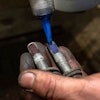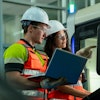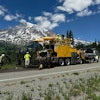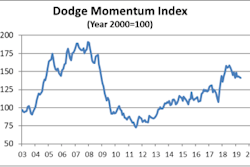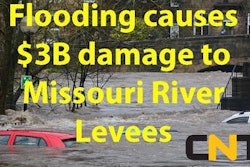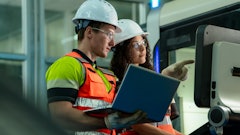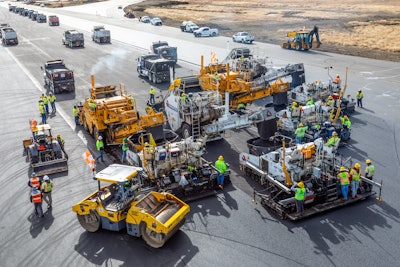
When Dallas Fort Worth International (DFW) Airport needed to rehabilitate its busiest arrival runway, the goals were to find a solution that used innovative engineering techniques, minimize the time the runway was out of service, support the airport’s commitment to sustainability and keep future maintenance costs low.
After more than 30 years of use at the world’s fourth busiest airport, DFW’s Runway 17C/35C was ready for a rehabilitation, becoming the first runway to be fully reconstructed since the airport’s opening in 1974. Arguably the most important of DFW Airport’s seven runways was out of commission for about six months while workers gave the 13,401-foot strip of pavement a $133 million makeover. DFW partnered with Jacobs, its on-call civil engineer, to evaluate the runway and determine options to move forward.
“Since 17C is the most-trafficked arrival runway at DFW, it was expected that after thousands of landings most of the runway would be compromised,” Johnny Jackson, Jacobs program manager says. “But our analysis showed that the runway’s base and the outer lanes still had a lot of life left, giving us more design alternatives.”
With this information, the team presented DFW with eight rehabilitation options ranging from full depth reclamation in Portland concrete cement to hot mix asphalt.
Asphalt Replaces Concrete
Factoring in cost and the time constraints associated with paving an airport runway, DFW chose to repave with asphalt which would give the pavement a 30-year life cycle and utilized more than 70% of the underlying layers. The rehabilitation of 17C, which handles 40% of the arrivals at DFW marks the first time the airport has used asphalt instead of concrete as a runway surface.
“Because of the findings under the runway’s surface, we were able to consider a structural asphalt overlay of the existing runway as an alternative to a full concrete replacement,” Brad McMullen, Jacobs project manager says. “Ultimately, this is what the airport chose to meet its future needs.”
Changing from concrete to asphalt achieved several benefits. Because there would be less demolition, the construction schedule was reduced – minimizing the amount of time the runway would be out of service. Costs were reduced as well; the construction estimate for full depth concrete replacement was upwards of $150 million. With the asphalt overlay option, total costs for the project were around $130 million. Asphalt also simplifies future runway maintenance through the next 40 years of its useful life, as repairs to asphalt can be done at night, instead of shutting down the runway for extended periods.
The mix design followed the FAA's P-401 specification and was developed using the Superpave method with a PG 82-22 binder. The high-density version of asphalt mix can withstand temperatures of 190° F without melting. Although asphalt is the main ingredient on the top layer, the runway also has a layer of concrete below the surface — and a stabilized, earthen base. Together, the components of the runway reach 5 ft., 6 in. deep.
Can't Control the Weather
As the contractor, Austin Bridge & Road (ABR) knew that controlling time was key to meeting the aggressive schedule and had many contingencies in place for supply chain issues, equipment breakdowns and weather. What ABR couldn't plan for was the rainiest September to December Dallas would experience in over 80 years.
To help mitigate some delay due to this weather, ABR chose aggregates with low absorption properties so in the event of rain, wet materials wouldn't be the cause of further delay. Three plants were also on standby to produce the mix that would keep up with the aggressive, and ever-changing, schedule. For about 10 days, all three plants were running and producing up to 5,000 tons a day. In all, 220,000 tons of asphalt was produced for the job.
Per the P-401 specification, ABR paved in echelon with four paving trains in two patterns. This was able to yield a 75-ft. wide hard mat with only two joints. Since temperatures needed to be above 40° F for compaction using the highly polymer modified binder, paving was limited to the warmest few hours of the day. This trimmed the paving day from 24 hours to just a few hours each day. In all, more than 200,000 hours of labor were needed to build the runway project.
Even though weather and change orders caused the project to exceed the schedule by three months, DFW still considered the project to be on time due to the scope addition and unexpected weather.
"The team endured one of the rainiest periods in DFW history and has upgraded our airfield to better serve our customers safely and efficiently for decades to come," Khaled Naja, DFW's executive vice president of infrastructure and development, said in a statement.
Sustainable Solutions
As the nation’s first carbon neutral airport, DFW has an unwavering commitment to sustainability. Jacobs developed a sustainable design strategy that incorporated ideas from design through construction. By keeping a good portion of the runway intact, there was significant reduction in the amount of materials going to a landfill, as well as the emissions from trucks to haul it there. Materials that could be reused on this or other airport construction projects were preserved.
In addition, the enhanced runway includes LED lighting, which can go for longer periods of time before being replaced and reduces the airport’s utility consumption.
Once into construction, DFW officials, Jacobs, ABR and all contractor teams worked closely together to execute the design, problem solving in real time to overcome unforeseen obstacles such as continued rainy weather. The project was funded through $80 million in Federal Aviation Administration grants.
“The completion of Runway 17C was a team effort with all parties focused on success as defined by DFW," Naja says. "As we look ahead to future airfield renovation and rehabilitation projects, 17C will be a model for reducing the impact on our operations thanks to innovative planning and the cooperation among all of the teams involved.”
